
By Steve Maxwell
Style and function in the junction – How Carmelin Design and Build created an award-winning project
Canadian Contractor Profiles Project Management Women in Construction How-to Smart House Best Overall Renovation Best Renovation BILD Awards Carmelin Design and Build Junction Triangle Oliver Rota Stephanie RotaWhen the new owners of a century home in Toronto’s Junction Triangle neighbourhood bought their 2200-square-foot brick place in 2019, they knew it was going to need a complete remodel and they wanted to start right away. That’s where the sister and brother team of Stephanie and Oliver Rota came in. Co-owners of Carmelin Design and Build, their team created an award-winning renovation that shows exceptional quality and attention to detail, and they did it by achieving six main goals.
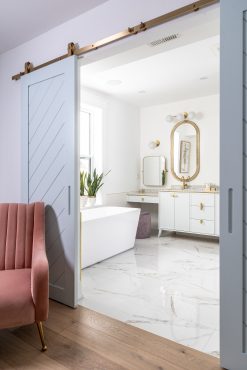
Goal#1: Boost functionality
“The clients for this project placed a high priority on functionality for their family home and making the most of the square footage for this project,” explains Stephanie. “They were happy to embrace design ideas, colours and materials outside of their comfort zone, resulting in a bold and beautiful home with as much character inside as the character of the Junction neighbourhood surrounding it.”
Work began by completely gutting the house from top to bottom, but with an added twist. “Our policy is to always get an environmental assessment of projects like this one,” explains Stephanie.” The purpose is to identify potentially hazardous building materials before demolition and construction disturb anything. Substances searched for include asbestos, lead, mercury, silica, arsenic, ethylene oxide and isocyanates, among others. As is typical with older homes there was some abatement required and it was easily dealt with safely.”
Carmelin was founded in 1984 by Stephanie and Oliver’s father, Mario Rota. “He settled in Canada with the first wave of Italian immigrants in the 1950s,” explains Stephanie. “He came from a long line of entrepreneurs and saw an opportunity in construction as a means to provide for his family. He was a charismatic, dynamic and honest man who put his heart into every project. Sadly, our dad passed away from cancer a few years ago, but we’re proudly continuing what he began.”
Carmelin is primarily a custom home builder, with 30 percent of their work going into renovations each year. “We consider ourselves a boutique builder and typically complete six to seven projects annually,” explains Stephanie.
Oliver and Stephanie take a hands-on approach to each project. “Our team also includes highly talented tradespeople, some of which have been with us for over 20 years,” says Stephanie. “We also match the right trades and suppliers to each specific project in terms of scale and scope. This ensures that the same quality and reliability are brought to each home we build.”
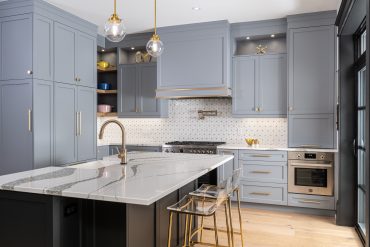
Goal#2: Get the design work right
“We always spend time getting to know our clients. Who’s in their family? How do they live? What do they want out of their home? What are the important features and less important ones?” explains Stephanie. “Sometimes clients have spent years planning out their project and know exactly what they want. Others have a concept, but want help from us, leveraging our experience to offer suggestions on what is possible for their space. We start by getting a set of design drawings with the layout of the existing home and then secondary drawings that show alternate layouts. There are many different scenarios but we narrow things down as we learn client preferences. The most difficult part of the design process comes when a trade-off is necessary between a wish list and the physical constraints of the project or the budget. We always work to find a solution that clients are happy with.”
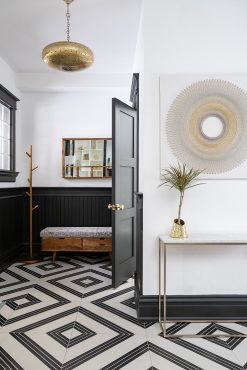
Goal#3: Open up the floor plan
As is common with older homes, the original floor plan of the Junction home included a lot of rooms and interior doors. Closed concept was common back then. “On projects like this, we work with a structural engineer to create an open floor plan using a combination of LVLs, steel beams and posts,” says Stephanie. “We aim to have posts hidden in existing walls to create the best look, avoiding awkwardly placed posts in the house. Open concept needs to be truly open.”
“The nature of home building is that new projects tend to generate referrals, and these referrals tend to cluster in a given neighbourhood. Currently, the majority of our work is in central Etobicoke. However, we also have a project in Danforth and have done work on a custom farmhouse north of the city. We’re happy to work anywhere in the Greater Toronto Area.”
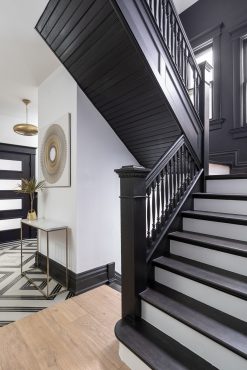
Goal#4: Create exceptional interior details
One of the striking things about this project is the interior millwork. No cookie-cutter stuff here. “Trim and moulding were supplied by Rex Lumber, and for this project, we worked directly with the owner of the company,” says Stephanie. “Wherever practical we aimed to preserve the old gumwood trim, but since this wasn’t always possible we did have new trim custom milled to match the old.” Pieces of existing trim were removed and taken to a shop for custom grinding of cutter knives and milling. “Many suppliers on this project are local family-run businesses and they bring a level of care and attention that our clients appreciate. “It’s not just about finding the lowest-cost provider,” says Stephanie. “Quality matters more.”
Walking through the house, the fit, finish and design of the trim will catch your eye. All finish work on this project was done by a very talented carpenter, Jose, who has been with Carmelin for more than 15 years. He took a lot of time and care blending the new trim into the old. Projects like this are a lot different than new construction.
Goal#5: Finish the attic and basement
“It was important to the client to utilize every square foot of the house, and this meant finishing both the basement and attic,” relates Stephanie. The original attic was one big uninsulated storage space – just the way builders of yesteryear often left completed home projects. Back then attics were the go-to space for stair-access of interior storage of seasonal clothes and other items because attics are drier and warmer than the old-style unfinished basements. “We redesigned the attic floor plan to accommodate two bedrooms with a shared bathroom in the middle. We also added skylights in the stairwell and a bathroom to bring in as much natural light as possible. The result was an entire new third floor of living space, fully insulated, giving two boys their privacy.”
The basement was completely finished along with the rest of the house. There’s now an outside entrance to the basement and a big mudroom, bathroom and rec room for the kids,” explains Stephanie. “Our assessment of the basement was that the block foundation walls were in very good shape and it was a dry basement. All in all, perfect for finishing.”
Goal#6: HVAC upgrade
“We made a decision in consultation with the client to eliminate the old HVAC system and replace it with new,” says Stephanie. “The layout of the house changed considerably from the original, and with two bedrooms on the third floor, an open concept on the main floor and a reconfiguration of the second-floor layout plus a finished basement, the old system of duct work was no longer going to properly serve the new home. The new forced-air HVAC system was designed by a consultant to handle the whole house.
Renovating an older home is about more than just making things new. The best projects also retain something of the history and character of yesteryear. While Carmelin’s Junction project has created a home that’s more comfortable and more usable than the original ever was, it’s still got something of that cool, old house feeling that people love so much.
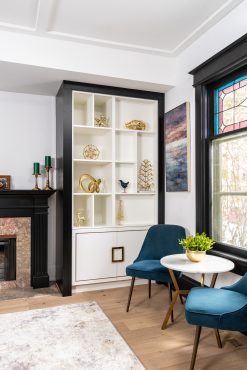
How to win home building awards
This past April, Carmelin won three BILD Awards, two of which are for the Junction home project: Best Overall Renovation and Best Renovation. So how do builders do well in competitions like these?
“Take lots of before and after photos and importantly from the same angles so you can really see the impact,” says Stephanie. “Be courageous with the finishes too. Convince the client to step outside their comfort zone; the results are surprising. It’s easy to match white and white. Go beyond that.”

Leave a Reply